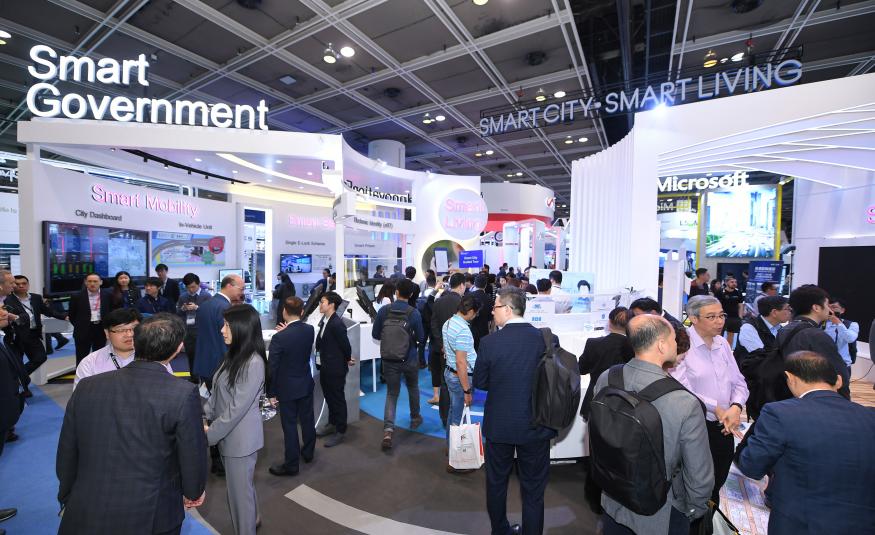The Hong Kong Trade Development Council (HKTDC) said its statistics show 236,000 buyers and 12,300 exhibitors gathered in Hong Kong for the seven tradefairs it organised in April alone, with over 9,500 coming from Mainland China and overseas.
Overseas tradefair participants are generating HK$1.3bn (US$170m) in income for Hong Kong according to extrapolations from new figures that show an average per capita spend of MICE overnight visitors of HK$8,218.
The tradefairs attracted buyers from 181 countries and regions, and the numbers were up 2% year-on-year.
The seven April tradefairs were: the HKTDC Hong Kong International Lighting Fair (Spring Edition), HKTDC Hong Kong Electronics Fair (Spring Edition), HKTDC International ICT Expo, HKTDC Hong Kong Houseware Fair, HKTDC Hong Kong International Home Textiles and Furnishings Fair, HKTDC Hong Kong Gifts & Premium Fair, and the Hong Kong International Printing & Packaging Fair. The latter was jointly organised by the HKTDC and CIEC Exhibition Company (HK) Ltd.
Benjamin Chau, HKTDC Deputy Executive Director, said: “The development of innovative technologies and smart products has become a major global trend. The seven April fairs offered an international trading platform for industry players to showcase their latest designs and innovations to global buyers and to test market response at first-hand.
"In addition, the HKTDC incorporated more innovation and technology (I&T) elements into the fairs to create additional opportunities for industry players and to bolster Hong Kong’s standing as the business hub of Asia and an international trade fair capital.”
Smart city surge
During the Spring Lighting Fair, Spring Electronics Fair, Houseware Fair and Gifts & Premium Fair, the HKTDC commissioned an independent research survey, interviewing 2,729 exhibitors and buyers to gauge their views on market prospects and product trends. More than 90% of respondents said they were either ‘optimistic’ or ‘neutral’ about smart city development in Hong Kong.
More I&T elements were included in this year’s April fairs and the ICT Expo adopted the theme of Smart City • Smart Living, showcasing an array of visionary smart city projects and applications.
These included the I&T initiatives featured at the Smart Government Pavilion presented by the Office of the Government Chief Information Officer of the HKSAR Government; the City Brain platform presented by the Hangzhou Government; and the innovative applications and solutions displayed at the ‘So French So Innovative’ pavilion.
Smart homes are an integral part of smart city development. At the Spring Lighting Fair, 89% of respondents said they consider the outlook for smart lighting in the coming two years to be promising (80%) or very promising (9%).
To facilitate the sourcing of smart home products, the Spring Lighting Fair launched the Innobuild zone, which showcased innovative building technologies and practical building tools, in addition to the Smart Lighting & Solutions zone.
The Spring Electronics Fair adopted similar initiatives and the Houseware Fair showcased a range of smart homewares and hosted a seminar to examine smart home and eco home product trends.
More than 90% of survey respondents also said they expected overall sales to rise (46%) or remain steady (45%), highlighting a general optimism among businesses in different fields.
The Outline Development Plan for the Guangdong-Hong Kong-Macao Greater Bay Area, released in February, seems to have grabbed the attention of players across different industries. Accordingly, the April tradefairs incorporated more Greater Bay Area elements to update participants on opportunities, including hosting a Greater Bay Area-related seminar and inviting mainland cities from the Greater Bay Area, including Foshan, Zhongshan, Zhuhai, Jiangmen and Dongguan, to set up group pavilions.
More than 80% of survey respondents hold positive or neutral views on the impact of the Greater Bay Area on their export performance in the coming six months.
Rising costs continue to be greatest business challenge, with survey respondents expecting increases in operating costs (46%) and price fluctuations in raw materials (37%) to continue to be the greatest business challenges this year. Fifty-two per cent of respondents anticipate that production costs or sourcing costs will increase, yet only 38% expect to raise free-on-board selling prices or retail prices, suggesting that industry professionals will not transfer additional costs to clients or consumers.
In terms of market prospects, respondents are generally positive about the outlook in traditional markets. Seventy-three per cent of respondents foresee Korea to be promising or very promising, followed by Taiwan (71%) and Hong Kong (69%). For emerging markets, 77% of respondents view Mainland China as promising or very promising this year, followed by ASEAN (72%) and South Africa (71%).





